
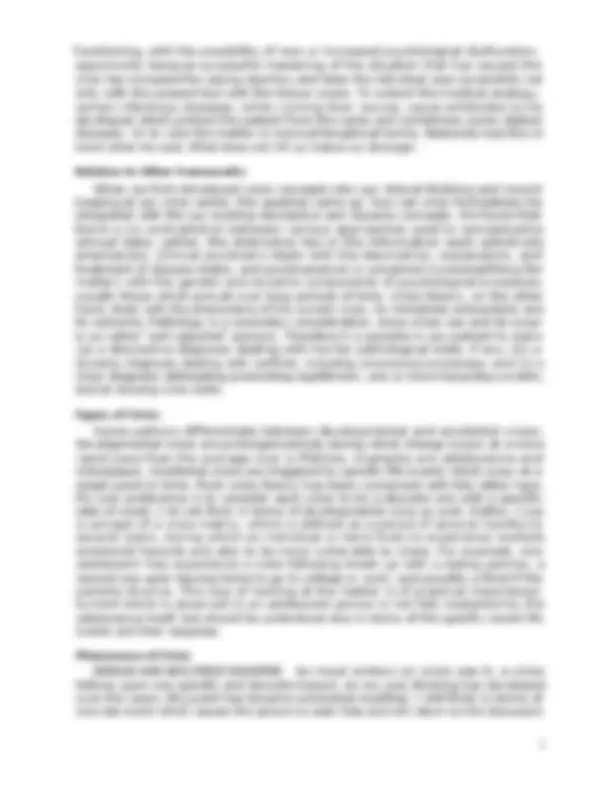
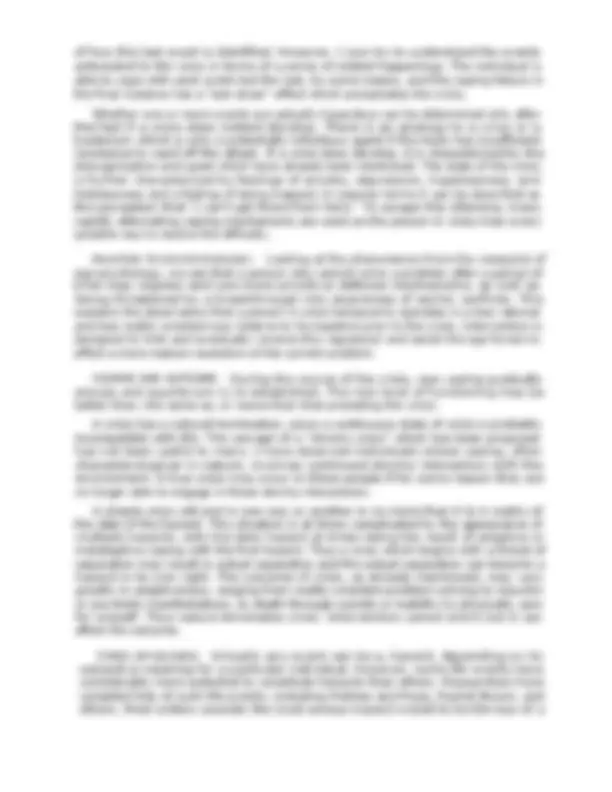
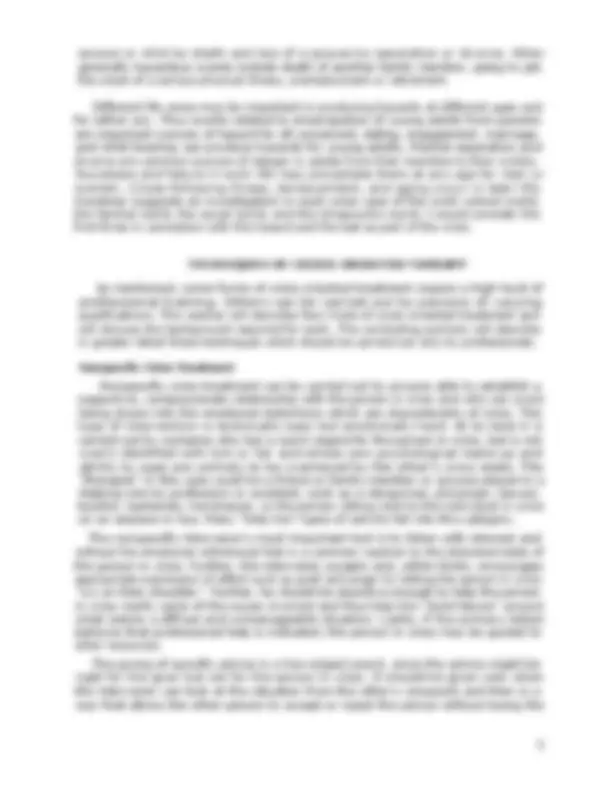
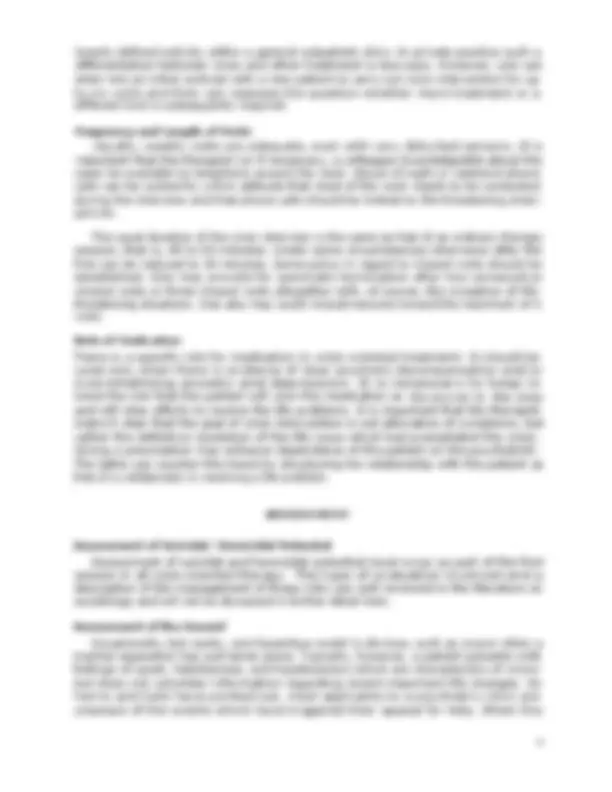
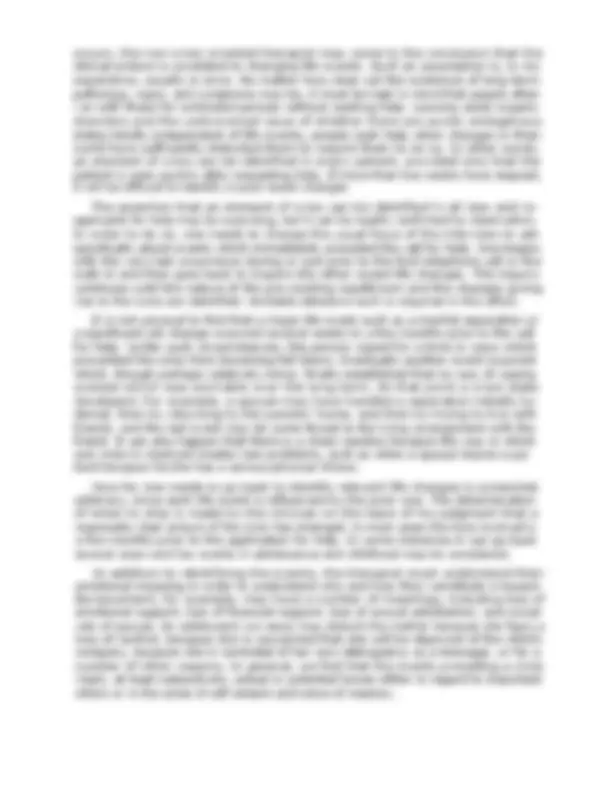



Study with the several resources on Docsity

Earn points by helping other students or get them with a premium plan


Prepare for your exams
Study with the several resources on Docsity

Earn points to download
Earn points by helping other students or get them with a premium plan
Community
Ask the community for help and clear up your study doubts
Discover the best universities in your country according to Docsity users
Free resources
Download our free guides on studying techniques, anxiety management strategies, and thesis advice from Docsity tutors
Crisis - Oriented Therapy in describes types of crisis, phenomena of crisis, techniques of crisis oriented therapy and individual crisis treatment.
Typology: Lecture notes
1 / 12

This page cannot be seen from the preview
Don't miss anything!







Gerald F. Jacobson, M.D.
There are few concepts that have been as divergently defined as those of crisis intervention or crisis-oriented treatment. Crisis treatment is widely believed to be li mited to situations involving life-threatening emergencies; to involve only telephone contacts or at most one or two visits; and to consist of activities that can be readily carried out by volunteers or others not trained as mental health specialists. None of these statements characterizes crisis-oriented therapy as it will be discussed in this paper. In the present context, crisis-oriented therapy is defined as a therapeutic modality which differs from other therapies in that it is based on crisis theory and is exclusively concerned with the identification, nature, and management of crisis.
Treatment is based on crisis theory and requires the same type of basic skills called for in any psychotherapy and is therefore carried out by trained mental health professionals. Crisis-oriented treatment is offered to anyone who perceives that his or her problems must be addressed without delay. Indications include but are not li mited to acute psychiatric emergency.
DEFINITIONS
In this section, three key terms relative to crisis intervention will be defined: crisis, hazard, and coping behavior.
after the hazard occurred; then at fluctuations in coping during the course of the crisis; and finally at coping after the crisis ends.
adaptive behavior, while other terms such as "defense" have been used to describe maladaptive patterns. In crisis theory, coping does not carry a value judgment; it may be adaptive or maladaptive. For example, a teenage boy may cope with parental conflict by abusing drugs. This coping behavior may be interrupted by drugs becoming unavailable and he may then cope by attempts at suicide, heavy drinking, and/or by open expression of rage at parents. He may reach an equilibrium where he copes by establishing improved relationships with his parents or by more effective separation from them, coupled with the establishment of other significant relations, or by becoming an alcoholic, by developing mental illness, or by committing suicide.
In the balance of this paper, the focus will be on the development of crisis theory more fully and then upon crisis-oriented therapy.
History
The forerunners of crisis theory are found chiefly in the literature of psychoanalysis. There are also important contributions from sociology, especially in regard to the theory of changes in social role. Freud was very much aware that current life events as well as historical factors were important in precipitating psychological problems, though he left that aspect for others to develop. Erikson contributed the concept of developmental crisis. He reviewed 'the life cycle and described typically encountered "crises," each of which presented the evolving individual with specific tasks which either were or were not adaptively resolved during a critical period.
The credit for the formulation of crisis theory as a specific framework under that name may belong to Erich Lindemann and Gerald Caplan. Lindemann's classic work on grief dealt with his investigations of relatives of people who had perished suddenly and tragically in a fire. He described normal grief and distinguished it from maladaptive responses to bereavement. He observed that a 6 week crisis followed the bereavement. At the end of that time there had either been a working through of the grief or, in some cases, a maladaptive outcome leading to psychotic or psychosomatic illness. Crisis theory was subsequently elaborated by a number of other workers including Harris, Jacobson, Kalis, Kaplan and Mason, Kardener, Langsley, Morley, Rapoport, Small, Strickler, and others.
Key Concept The following is a key concept related to crisis theory: Crisis is a time-limited phenomenon with an outcome that is not predetermined at the start of the crisis. This outcome has major significance for the future well-being of the individual. An analogy can be made to the crisis of pneumonia before the days of antibiotics. That crisis lasted a few days, at the end of which the patient either recovered or died. Similarly, each psychological crisis has a potential for a great variety of eventual resolutions. This aspect is said to be symbolized by the Chinese character for crisis, which combined the pictographs for both "danger" and "opportunity;" danger because the failure of existing coping mechanisms results in risk to previous
of how this last event is identified. However, I now try to understand the events antecedent to the crisis in terms of a series of related happenings. The individual is able to cope with each event but the last, by some means, and the coping failure in the final instance has a "last straw" effect which precipitates the crisis.
Whether one or more events are actually hazardous can be determined only after the fact if a crisis does indeed develop. There is an analogy to a virus or a bacterium which is only a potentially infectious agent if the body has insufficient resistance to ward off the attack. If a crisis does develop, it is characterized by the disorganization and upset which have already been mentioned. The state of the crisis is further characterized by feelings of anxiety, depression, hopelessness, and helplessness and a feeling of being trapped. In popular terms it can be described as the perception that "I can't get there from here." To escape this dilemma, many rapidly alternating coping mechanisms are used as the person in crisis tries every possible way to resolve the difficulty.
RELATION TO EGO PSYCHOLOGY. Looking at the phenomenon from the viewpoint of ego psychology, we see that a person who cannot solve a problem after a period of ti me may regress and use more primitive defense mechanisms, as well as being threatened by a breakthrough into awareness of earlier conflicts. This explains the observation that a person in crisis temporarily operates in a less rational and less reality-oriented way relative to his baseline prior to the crisis. Intervention is designed to limit and eventually reverse this regression and assist the ego forces to effect a more mature resolution of the current problem.
COURSE AND OUTCOME. (^) During the course of the crisis, new coping gradually ensues and equilibrium is re-established. The new level of functioning may be better than, the same as, or worse than that preceding the crisis. A crisis has a natural termination, since a continuous state of crisis is probably incompatible with life. The concept of a "chronic crisis" which has been proposed has not been useful to many. I have observed individuals whose coping, often characterological in nature, involves continued stormy interaction with the environment. A true crisis may occur in these people if for some reason they are no longer able to engage in these stormy interactions. A simple crisis will end in one way or another in no more than 4 to 6 weeks of the date of the hazard. This situation is at times complicated by the appearance of multiple hazards, with the later hazard at times being the result of adaptive or maladaptive coping with the first hazard. Thus a crisis which begins with a threat of separation may result in actual separation and the actual separation can become a hazard in its own right. The outcome of crisis, as already mentioned, may vary greatly in adaptiveness, ranging from reality-oriented problem-solving to neurotic or psychotic manifestations, to death through suicide or inability to physically care for oneself. Thus nature terminates crisis. Intervention cannot end it but it can affect the outcome.
TYPES OF HAZARD. Virtually any event can be a, hazard, depending on its subjective meaning for a particular individual. However, some life events have considerably more potential to constitute hazards than others. Researchers have compiled lists of such life events, including Holmes and Raye, Paykel Brown, and others. Most writers consider the most serious hazard overall to be the loss of a
spouse or child by death and loss of a spouse by separation or divorce. Other generally hazardous events include death of another family member, going to jail, the onset of a serious physical illness, unemployment or retirement.
Different life areas may be important in producing hazards at different ages and for either sex. Thus events related to emancipation of young adults from parents are important sources of hazard for all concerned; dating, engagement, marriage, and child-bearing can produce hazards for young adults. Marital separation and divorce are common sources of danger in adults from their twenties to their sixties. Successes and failure in work life may precipitate them at any age for men or women. Crises following illness, bereavement, and aging occur in later life. Kardener suggests an investigation in each crisis case of the work-school world, the familial world, the social world, and the intrapsychic world. I would consider the first three in connection with the hazard and the last as part of the crisis.
TECHNIQUES OF CRISIS-ORIENTED THERAPY
As mentioned, some forms of crisis-oriented treatment require a high level of professional training. Others can be carried out by persons of varying qualifications. This section will describe four kinds of crisis-oriented treatment and will discuss the background required for each. The concluding portions will describe in greater detail those techniques which should be carried out only by professionals.
Nonspecific Crisis Treatment Nonspecific crisis treatment can be carried out by anyone able to establish a supportive, compassionate relationship with the person in crisis and who can avoid being drawn into the emotional distortions which are characteristic of crisis. This type of intervention is technically easy but emotionally hard. At its best it is carried out by someone who has a warm regard for the person in crisis, but is not overly identified with him or her and whose own psychological make-up and ability to cope are unlikely to be overtaxed by the other's crisis state. The "therapist" in this case could be a friend or family member or anyone placed in a helping role by profession or accident, such as a clergyman, physician, lawyer, teacher, bartender, hairdresser, or the person sitting next to the individual in crisis on an airplane or bus. Many "help line" types of activity fall into this category. The nonspecific intervener's most important tool is to listen with interest and without the emotional withdrawal that is a common reaction to the disturbed state of the person in crisis. Further, the intervener accepts and, within limits, encourages appropriate expression of affect such as grief and anger by letting the person in crisis "cry on their shoulder." Further, he should be objective enough to help the person in crisis clarify some of the issues involved and thus help him "build fences" around what seems a diffuse and unmanageable situation. Lastly, if the primary helper believes that professional help is indicated, the person in crisis may be guided to other resources. The giving of specific advice is a two-edged sword, since the advice might be right for the giver but not for the person in crisis. It should be given only when the intervener can look at the situation from the other's viewpoint and then in a way that allows the other person to accept or reject the advice without losing the
The advantage of generic crisis intervention is that it does not require that one deal with the unique characteristics of each separate individual. For purposes of this type of intervention, all individuals undergoing a given hazard (bereavement, prematurity, divorce, disaster, etc.) are assumed to have similar patterns of response. The term "generic" refers to the view that all such people belong to a kind or "genus." It is thus possible to apply this technique to large numbers of persons. This feature, however, also constitutes a disadvantage since not all individuals are in fact alike. What may be adaptive for one person may be maladaptive for another. Further, there are a number of hazards in regard to which little or no information about generic adaptive coping is available.
Individual Crisis-Oriented Treatment The other three kinds of crisis treatment are often insufficient. Thus, individual crisis treatment was born. It may be used in addition to one or more of the above three methods or by itself. It requires the skills of mental health professionals. It differs from generic crisis treatment in that it does not assume that any particular way of coping is desirable for a given person. Rather, it is concerned with the unique assessment of the hazard(s) within the context of the individual circumstances and with forming a plan for intervention which is derived from that assessment. The remainder of this paper will deal with individual crisis-oriented treatment.
INDIVIDUAL CRISIS TREATMENT
GENERAL CONSIDERATIONS
Number of Visits A firm limit should be placed on the number of visits at the outset. The most frequently used maximum number of visits is six, typically conducted at weekly intervals. Since the duration of an uncomplicated crisis is four to six weeks after the date of the (last) hazard, weekly crisis intervention for up to six visits dovetails naturally with the course of the crisis. If patient and therapist work together longer, non-crisis related subjects will be addressed and once that occurs there is no natural ending point to the intervention. Further experience indicates that a pre-set ti me limit produces a "pressure cooker" type of situation which motivates therapist and patient to invest maximum effort in the work of resolving the crisis optimally. Visits in excess of six should occur very rarely and be limited to circumstances when either termination would leave the patient in a life-threatening situation or when a second hazard which occurred during the first period of crisis treatment can be clearly identified.
Setting A pre-set limit to the number of visits is most practical in community settings where treatment can be carried out in a crisis clinic separate from other programs. If and when further treatment is needed at the end of crisis intervention, the patient can and should be referred to another facility or branch of the same facility. Such an arrangement works better than trying to carry out crisis intervention as a
loosely defined activity within a general outpatient clinic. In private practice such a differentiation between crisis and other treatment is less easy. However, one can enter into an initial contract with a new patient to carry out crisis intervention for up to six visits and then can reassess the question whether more treatment or a different kind is subsequently required.
Frequency and Length of Visits Usually, weekly visits are adequate, even with very disturbed persons. It is i mportant that the therapist (or if necessary, a colleague knowledgeable about the case) be available by telephone around the clock. Abuse of night or weekend phone calls can be curbed by a firm attitude that most of the work needs to be conducted during the interview and that phone calls should be limited to life-threatening emer- gencies.
The usual duration of the crisis interview is the same as that of an ordinary therapy session, that is, 45 to 50 minutes. Under some circumstances interviews after the first can be reduced to 30 minutes. Some policy in regard to missed visits should be established. One may provide for automatic termination after two consecutive missed visits or three missed visits altogether with, of course, the exception of life- threatening situations. One also may count missed sessions toward the maximum of 6 visits.
Role of Medication
There is a specific role for medication in crisis-oriented treatment. It should be used only when there is evidence of clear psychotic decompensation and/or overwhelming anxiety and depression. It is necessary to keep in mind the risk that the patient will view the medication as (^) the answer to the crisis and will relax efforts to resolve the life problems. It is important that the therapist make it clear that the goal of crisis intervention is not alleviation of symptoms, but rather the definitive resolution of the life issue which had precipitated the crisis. Giving a prescription may enhance dependence of the patient on the psychiatrist. The latter can counter this trend by structuring his relationship with the patient as that of a collaborator in resolving a life problem.
ASSESSMENT
Assessment of Suicidal/ Homicidal Potential
Assessment of suicidal and homicidal potential must occur as part of the first session in all crisis-oriented therapy. The type of evaluation involved and a description of the management of these risks are well reviewed in the literature on suicidology and will not be discussed in further detail here.
Assessment of the Hazard
Occasionally, but rarely, one hazardous event is obvious, such as occurs when a marital separation has just taken place. Typically, however, a patient presents with feelings of upset, helplessness, and hopelessness (which are characteristic of crisis) but does not volunteer information regarding recent important life changes. As Harris and Kalis have pointed out, most applicants to a psychiatric clinic are unaware of the events which have triggered their appeal for help. When this
roi
The end result of this investigation is a time line which can be drawn on a piece of paper. At one end of the line is the date and time of the first contact with the helping resource, and the event that occurred closest to that contact is listed. Further along the line are earlier dates and the associated antecedent events that are relevant to the crisis. Events are recorded as far back in time as is necessary in order to make the line a graphic representation of the genesis of the crisis.
Assessment of the Crisis In addition to plotting a time line, the therapist also assesses the intensity of the crisis and the existing reservoir of ego strength. This understanding is necessary to determine whether outpatient treatment is possible or whether hospitalization is indicated. Beyond that, it is of use in alerting the therapist to the fragility or strength of the ego. The therapist will also, as part of his assessment of the crisis, obtain an understanding of longer-term coping mechanisms, both adaptive and maladaptive, as well as of emergency or short-term mechanisms used in the crisis and those that he believes will be available and useful to the patient in resolving the crisis.
TREATMENT
In general, the therapist must be consistently concerned, involved, attentive and empathic. He or she needs to be active in exploring the situation but not authoritative in imposing a solution. More specifically, treatment can be divided into cognitive understanding; acknowledgement of affect; and establishment of new coping. Cognitive Understanding Cognitive aspects of crisis treatment help the patient gain a better grasp and therefore a greater mastery by understanding the nature of the crisis and the events which have generated it. To this end the therapist communicates to the patient his understanding of the chain of events at a level which the patient can integrate within the available time. In all cases the formulation should include identification of the specific hazardous event(s), the meaning of these events to the patient, the previous coping mechanisms used, the reasons why they are no longer available and an exploration of what adaptive mechanisms may now be brought into play. In discussing these matters, formulations relating to ego functions and to reality are usually employed. For example, a patient may learn that what appears to be inexplicable anger and depression is related to a recent departure by the spouse on an extended trip. Similarly, a patient may realize that the unexpected arrival of a disturbed relative has upset her previous balance and requires measures to resolve the issues. Such explanations are more easily integrated than those which focus on intrapsychic conflicts and they also lead directly to the formulation of appropriate courses of action. In other words, intervention should stay relatively close to the surface in terms of a surface-depth continuum. There are a few exceptions relating to individuals with much ego strength and/or with considerable prior insight therapy. In such instances the crisis provides opportunity to learn or to reconfirm insights. The therapist should not raise long-term issues unrelated to the crisis. A classic example of what not to do relates to individuals in the acute phase of marital separation. All too often the therapist, perhaps at the request of a depressed and self-blaming patient, will go into all of the mistakes which the patient made which contributed to the failure of the marriage. Such a stance will result not only in
inability to work toward resolving the issues about the separation, but will further i mpair self-esteem, disrupt ego integration, and generally worsen the clinical state. Appropriate crisis work here deals with determining whether or not the separation is permanent and with working through the loss, if it is.
Once the crisis is formulated at an appropriate level, it is not unusual for the patient to respond with a literal or figurative sigh of relief. Determining specific issues "builds fences" around what previously seemed to be an unmanageable multitude of stresses. Much of the therapeutic work is done right then and there.
Acknowledgement of Affect The therapist must be genuinely open to acknowledgement and expression of appropriate feelings such as grief and anger, and should be careful lest a pedantic approach to the cognitive portion of crisis treatment block such affects. If there is a real loss, recognition and expression of grief is very important. Other crisis-related affects, particularly anger, should also be brought into awareness. However, the patient should be encouraged to deal with guilt over anger before expressing it and also be helped to direct his anger into appropriate, reality-oriented channels. Repressive affects including those based mainly on projection should not be elicited or encouraged.
Establishing New Coping When crisis treatment works best, understanding the nature of the crisis is gained and shared in the first or at most, the second visit. The treatment visits - up to six - consist of the patient and therapist jointly working together to determine what approach is best to deal with the now defined problem. While some of the crisis approach may be intrapsychic, it typically includes discussions of appropriate problem-solving behavior which enhances a sense of mastery. Advice is not usually needed or helpful. The patient is often a much better judge of what is possible and adaptive for him than the therapist.
The limits of what can be achieved in the way of adaptiveness differ for each person and the therapist must be very sensitive to these limits. It is quite possible for the therapist to expect in his or her mind either too much or too little in regard to the ultimate outcome. One particular pitfall into which the intervener who is usually achievement-oriented often falls is to expect a great deal of independent action, of which the patient may not be capable. The patient, sensing he has disappointed the therapist, may become discouraged and not return. During the phase of developing and consolidating new coping behavior, the therapist may offer resource information and/or refer the patient to other places where such information is available.
Termination In the last phase of crisis intervention the gains made are reviewed. Possible future hazards and ways of dealing with them should be discussed. This step completes the intervention. Only after intervention is over should the patient and therapist discuss the question of whether further treatment is indicated for long- standing problems. Such therapy ideally should not be by the person who did the crisis intervention, though in private practice it is usually impossible to have a different therapist for the longer-term treatment phase. We have found that in a crisis clinic the majority of people are not referred for ongoing treatment. Lastly, the therapist deals with feelings of separation, relating this issue to dealing with losses